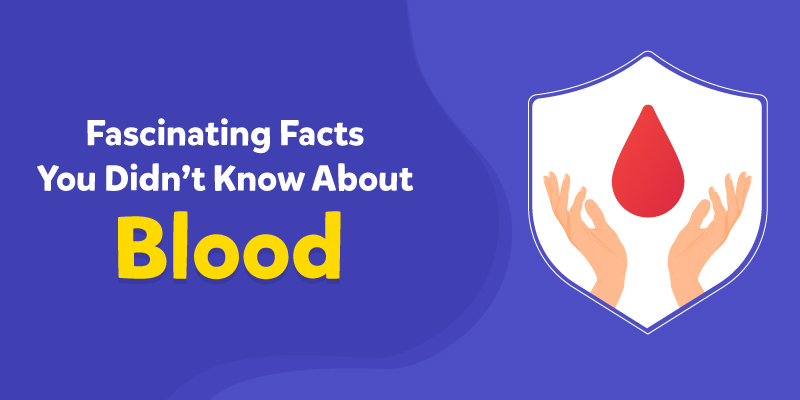
Blood is definitely the most important fluid in our body, especially because it is the life-giving fluid that delivers oxygen to all the cells of the body. In the absence of blood, the human body will fail to receive any oxygen which will result in death.
This is the basic and the most important fact about blood but there are several more surprising facts that you don’t know about yet. But things are about to change. Did you know blood accounts for about eight percent of your body weight and contains trace amounts of gold?
Are you intrigued yet? Then let’s get into more unusual and unknown facts about blood.
Did you know that nearly eight percent of our body weight is made up of blood? Well, yes. The amount of blood in a person’s body depends on their age and size. Losing a certain amount of blood does not cause any harm to the body. According to research and several studies, blood accounts for approximately seven to eight percent of an adult’s body weight.
Blood also consists of a yellow liquid which is known as blood plasma. Plasma carries water, salts and enzymes. The main role of plasma is to take nutrients, hormones, and proteins to the parts of our body that need it. Cells also put their waste products into the plasma.
Several studies and research have suggested that coconut water is identical to human plasma and can be injected directly into the human bloodstream. This story has its origins in World War II, when British and Japanese soldiers were given coconut water intravenously because saline solution was in short supply. But under normal circumstances, doctors today have stated that while it might not be harmful, they wouldn’t be inclined to set up a coconut water IV for dehydrated patients. The reason behind this is that coconut water isn’t identical to plasma but closer to the liquid inside the red blood cells, with low sodium and high potassium content.
A newborn baby will have around one cup of blood in its body. A newborn’s body makes more red blood cells than adults. Mean corpuscular volume (MCV) of newborns is greater than that of adults because of young red cells. There is a negative correlation between blood viscosity and MCV. High MCV in babies leads to low blood viscosity in newborns, as compared to adults.

Red blood cells consist of haemoglobin. Haemoglobin is actually a protein that contains iron. Oxygen combines with this iron and gives the characteristic red colour that we see in our blood. This property of iron is the reason why we apply paint on iron articles. Doing so helps prevent oxygen from combining with iron.
Unlike red blood cells, the white blood cells in our blood help form the defensive system of our body. These white blood cells are responsible for fighting viruses, bacteria and other infectious diseases. They also fight cancer cells and other unwanted material that enter the human body.
Platelets are completely different from white blood and red blood cells and are responsible for blood clotting whenever bleeding occurs because of a cut or bruise. This prevents unwanted loss of blood from our bodies.
Exposing a person’s skin to ultraviolet rays reduces blood pressure by causing levels of nitric oxide to rise in the blood. Nitric oxide helps to regulate blood pressure by reducing blood vessel tone.
The average volume of blood present in an adult male body is 5.6 litres while an adult female body contains 4.5 litres of blood on average.
The first-ever blood bank of the world was opened in Chicago in 1937. Back in the same year, Bernard Fantus, director of therapeutics at the Cook County Hospital in Chicago, established the first hospital blood bank in the US. Fantus created the term “blood bank” as the hospital laboratory preserved, refrigerated and stored donor blood.
We are all familiar with common blood types A, B, AB and O, which is a part of the simplified ABO system. Rhesus (Rh) factor is an inherited protein found on the surface of red blood cells. But why do some people have positive and some negative blood groups? Rhesus (Rh) factor is an inherited protein found on the surface of red blood cells. If your blood has the protein, you’re Rh positive. If your blood lacks the protein, you’re Rh negative.
Rh positive is the most common blood type. Having an Rh negative blood type can however, affect pregnancy. A baby can inherit the Rh factor from either parent. During a pregnancy, Rh antibodies made in a woman’s body can cross the placenta and attack the Rh factor on fetal blood cells. This can cause a serious type of anemia in the fetus in which red blood cells are destroyed faster than the body can replace them.
Do you have more interesting facts that you wish to share with us? Tell us all about it in the comments below.
Enjoyed reading this? Find more such cool content on The Learning Tree blog:
8 Eye-Opening Facts About Human Eyes You Must Know!
Optical Illusions Found in Nature That aren’t What They Seem
Writing has always been Shreesha’s passion, be it for imparting knowledge or expressing opinions. In her former role as a journalist, she contributed to enriching society with knowledge. Now, at BYJU’S, she has moved on to something more exciting – creating tailor-made content for students. When she is not writing, you would find her looking for new ways to engage her child.